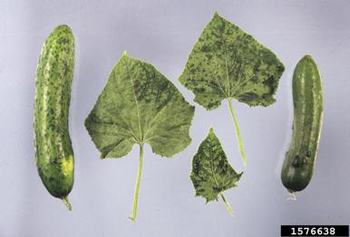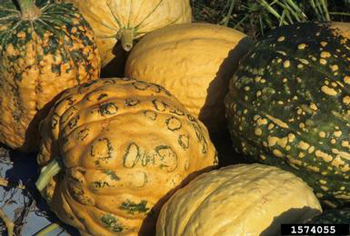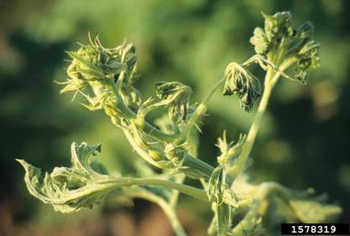PLANT PEST

Gerald Holmes, California Polytechnic State University at San Luis Obispo, Bugwood.org
Tobamoviruses (exotic strains)
Exotic to Australia
Exotic to Australia: One key virus, cucumber green mottle mosaic virus (CGMMV), is under management in some areas of Australia.
Features: A group of viral diseases that cause mottling and damage to important vegetable, fruit, field and ornamental plants.
Where it’s from: Asia, Nigeria, North America, Brazil, and Europe.
How they spread: Importation of infected plants and plant material including seeds; local spread through plant to plant contact; pruning, harvesting, contaminated equipment and clothing.
At risk: Many vegetable crops including melons, squash, tomatoes, potatoes, and capsicum.
Australian Chief Plant Protection Officer, Dr Gabrielle Vivian-Smith, provides an overview of the risks posed by seed viruses, including Tobamoviruses
Download
| Document | Page | File size |
|---|---|---|
| Transcript DOCX | 1 | 16 KB |
If you have difficulty accessing these files, visit web accessibility for assistance.
Keep it out
Tobamoviruses threaten many of Australia’s vegetable, fruit and field crops.
Tobamoviruses are highly infectious. Their primary method of spread is through the trade of infected seed around the world. The virus can survive for long periods in plant material, contaminated soil and on equipment surfaces. Therefore, tobamoviruses spread easily through direct plant to plant contact, contaminated tools, hands, clothing and by pollinators like bees visiting flowers.
Plants infected with tobamoviruses have mosaic-like mottling and discolouration on the leaves and fruit. These viruses don’t affect human health, but they cause a great deal of damage to infected plants through the reduction of both plant health and production of fruit and vegetables. Many plant species can be infected with the viruses, including many important vegetable, fruit and field crops.
One of the key tobamoviruses, cucumber green mottle mosaic virus, affects cucurbits – pumpkins, melons and related fruit and vegetables. Infected plants produce little fruit and, since there is no cure, they must be destroyed. It now occurs on all continents except South America.
In addition to cucumber green mottle mosaic virus, tobamoviruses include tomato mottle mosaic virus, zucchini green mottle mosaic virus, cucumber mottle virus and tobacco mosaic virus – potato strain.
Importing goods
To keep exotic strains of tobamoviruses out of Australia, never ignore Australia’s strict biosecurity rules.
Import shipments may need to be treated and certified, so before you import, check our Biosecurity Import Conditions system (BICON).
What to look for
Symptoms vary depending on the plant, but look out for:
- mosaic-like mottling and discoloration on the leaves
- distorted leaves
- absence of fruit or distorted fruit.

Gerald Holmes, California Polytechnic State University at San Luis Obispo, Bugwood.org

Gerald Holmes, California Polytechnic State University at San Luis Obispo, Bugwood.org
Where to look
Importers
Importation of infected seed, plants and plant material is the most likely way that tobamoviruses could make it to Australia.
Growers and home gardeners
Look out for signs of tobamovirus infection in your garden and among your melon and vegetable crops including mottling of leaves and fruit. The virus can only be identified in a laboratory.
The viruses can infect some weed species including prostrate pigweed and creeping cucumber, so good farm hygiene is recommended for growers.
Look for symptoms in:
- vegetables in the pumpkin and melon family
- tomato
- potato
- chilli
- capsicum
- field crops including tobacco and wheat.
Secure any suspect specimens
If you think you’ve found a plant infected with tobamovirus:
- take a photo
- collect a sample
- do not disturb the infected plants (this may be as simple as closing the doors on a shipping container or preventing access to a field).
